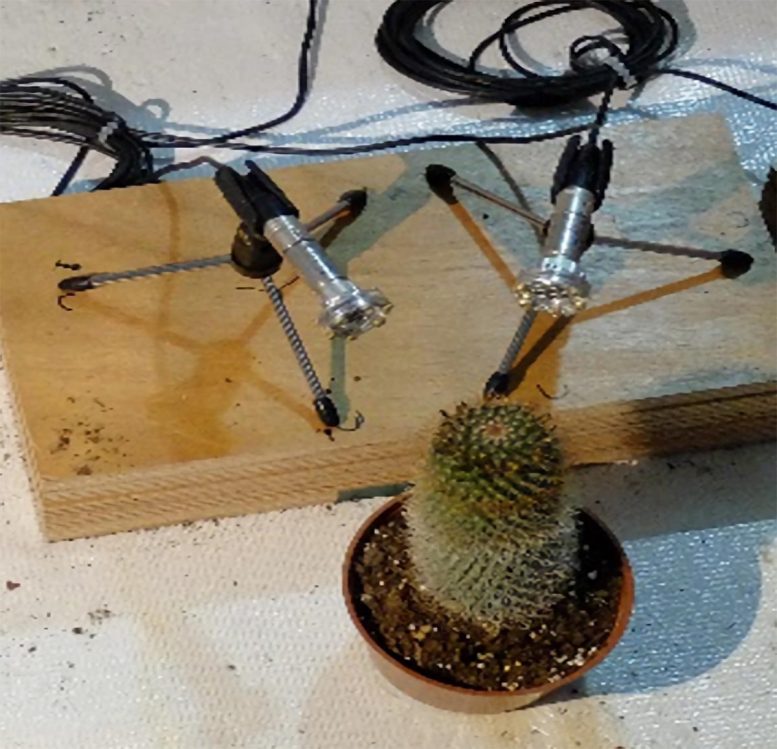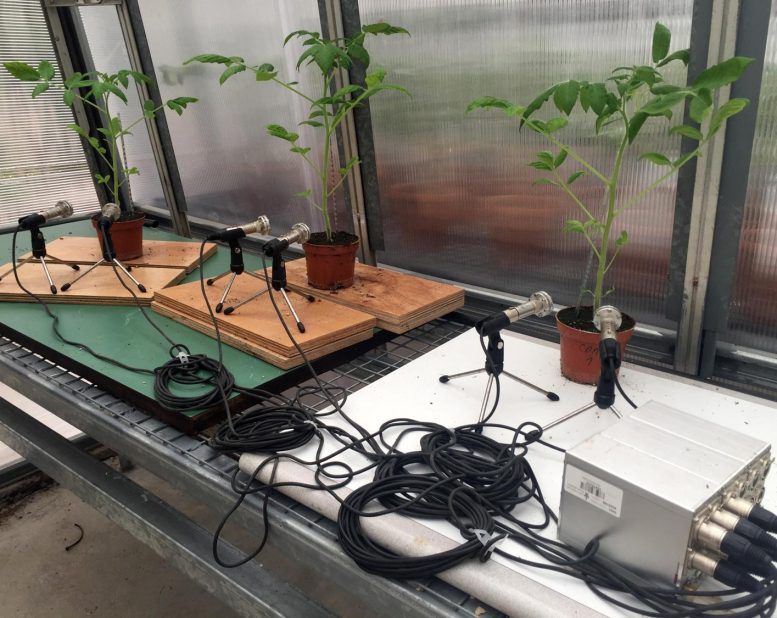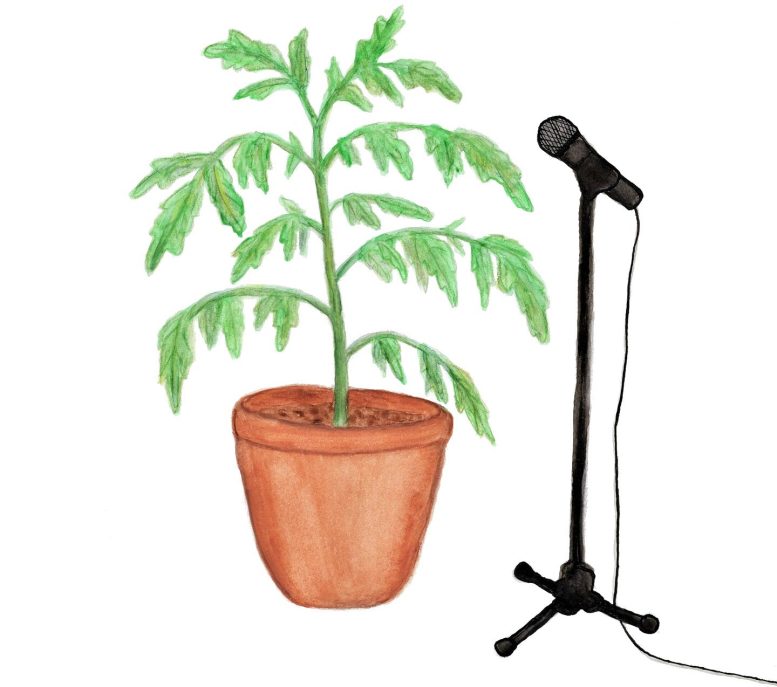
Researchers at Tel Aviv University have discovered that stressed tomato and tobacco plants emit sounds similar to bubble-wrap being popped. These ultrasonic noises, which are inaudible to humans, may be detectable by insects, other mammals, and possibly other plants. The sounds could be a form of communication, carrying information about plant stress levels. Using microphones, the team recorded the sounds of healthy and stressed plants and trained a machine-learning algorithm to differentiate between the types of stress and plant species. The findings open new possibilities for understanding plant communication and have potential applications in agriculture for monitoring crop hydration and optimizing irrigation systems.
Stressed tomato and tobacco plants emit ultrasonic sounds similar to bubble-wrap popping, which may be detectable by insects, mammals, and other plants. Researchers recorded the sounds and used machine-learning to identify stress types and plant species, offering insights into plant communication and potential agricultural applications.
What does a stressed plant sound like? A bit like bubble-wrap being popped. Researchers in Israel report in the journal Cell on March 30 that tomato and tobacco plants that are stressed—from dehydration or having their stems severed—emit sounds that are comparable in volume to normal human conversation. The frequency of these noises is too high for our ears to detect, but they can probably be heard by insects, other mammals, and possibly other plants.
“Even in a quiet field, there are actually sounds that we don’t hear, and those sounds carry information,” says senior author Lilach Hadany, an evolutionary biologist and theoretician at Tel Aviv University. “There are animals that can hear these sounds, so there is the possibility that a lot of acoustic interaction is occurring.”
Although ultrasonic vibrations have been recorded from plants before, this is the first evidence that they are airborne, a fact that makes them more relevant for other organisms in the environment. “Plants interact with insects and other animals all the time, and many of these organisms use sound for communication, so it would be very suboptimal for plants to not use sound at all,” says Hadany.

This is a photo of a cactus being recorded. Credit: Itzhak Khait
The researchers used microphones to record healthy and stressed tomato and tobacco plants, first in a soundproofed acoustic chamber and then in a noisier greenhouse environment. They stressed the plants via two methods: by not watering them for several days and by cutting their stems. After recording the plants, the researchers trained a machine-learning algorithm to differentiate between unstressed plants, thirsty plants, and cut plants.
The team found that stressed plants emit more sounds than unstressed plants. The plant sounds resemble pops or clicks, and a single stressed plant emits around 30–50 of these clicks per hour at seemingly random intervals, but unstressed plants emit far fewer sounds. “When tomatoes are not stressed at all, they are very quiet,” says Hadany.
This is an audio recording of plant sounds. The frequency was lowered so that it is audible to human ears. Credit: Khait et al.
Water-stressed plants began emitting noises before they were visibly dehydrated, and the frequency of sounds peaked after 5 days with no water before decreasing again as the plants dried up completely. The types of sound emitted differed with the cause of stress. The machine-learning algorithm was able to accurately differentiate between dehydration and stress from cutting and could also discern whether the sounds came from a tomato or tobacco plant.
Although the study focused on tomato and tobacco plants because of their ease to grow and standardization in the laboratory, the research team also recorded a variety of other plant species. “We found that many plants—corn, wheat, grape, and cactus plants, for example—emit sounds when they are stressed,” says Hadany.
The exact mechanism behind these noises is unclear, but the researchers suggest that it might be due to the formation and bursting of air bubbles in the plant’s vascular system, a process called cavitation.

This is a photo of three tomato plants whose sounds are being recorded in a greenhouse. Credit: Ohad Lewin-Epstein
Whether or not the plants are producing these sounds in order to communicate with other organisms is also unclear, but the fact that these sounds exist has big ecological and evolutionary implications. “It’s possible that other organisms could have evolved to hear and respond to these sounds,” says Hadany. “For example, a moth that intends to lay eggs on a plant or an animal that intends to eat a plant could use the sounds to help guide their decision.”
Other plants could also be listening in and benefiting from the sounds. We know from previous research that plants can respond to sounds and vibrations: Hadany and several other members of the team previously showed that plants increase the concentration of sugar in their nectar when they “hear” the sounds made by pollinators, and other studies have shown that plants change their gene expression in response to sounds. “If other plants have information about stress before it actually occurs, they could prepare,” says Hadany.
Sound recordings of plants could be used in agricultural irrigation systems to monitor crop hydration status and help distribute water more efficiently, the authors say.

This is an illustration of a dehydrated tomato plant being recorded using a microphone. Credit: Liana Wait
“We know that there’s a lot of ultrasound out there—every time you use a microphone, you find that a lot of stuff produces sounds that we humans cannot hear—but the fact that plants are making these sounds opens a whole new avenue of opportunities for communication, eavesdropping, and exploitation of these sounds,” says co-senior author Yossi Yovel, a neuro-ecologist at Tel Aviv University.
“So now that we know that plants do emit sounds, the next question is—‘who might be listening?’” says Hadany. “We are currently investigating the responses of other organisms, both animals and plants, to these sounds, and we’re also exploring our ability to identify and interpret the sounds in completely natural environments.”
For more on this discovery, see Scientists Record Ultrasonic Distress Calls From Stressed Flora.
Reference: “Sounds emitted by plants under stress are airborne and informative” by Itzhak Khai, Ohad Lewin-Epstein, Raz Sharon, Kfir Saban, Revital Goldstein, Yehuda Anikster, Yarden Zeron, Chen Agassy, Shaked Nizan, Gayl Sharabi, Ran Perelman, Arjan Boonman, Nir Sade, Yossi Yovel and Lilach Hadany, 30 March 2023, Cell.
DOI: 10.1016/j.cell.2023.03.009
This research was supported by the Israel Science Foundation Bikura Fund, the Manna Center Program for Food Safety and Security fellowships, and the Clore Foundation Scholars Programme.









It has always amazed me how the tomatto worm, moth finds a tomatto plant, This is a big possibility
Do plants understand clucking chickens; or is it the other way round?